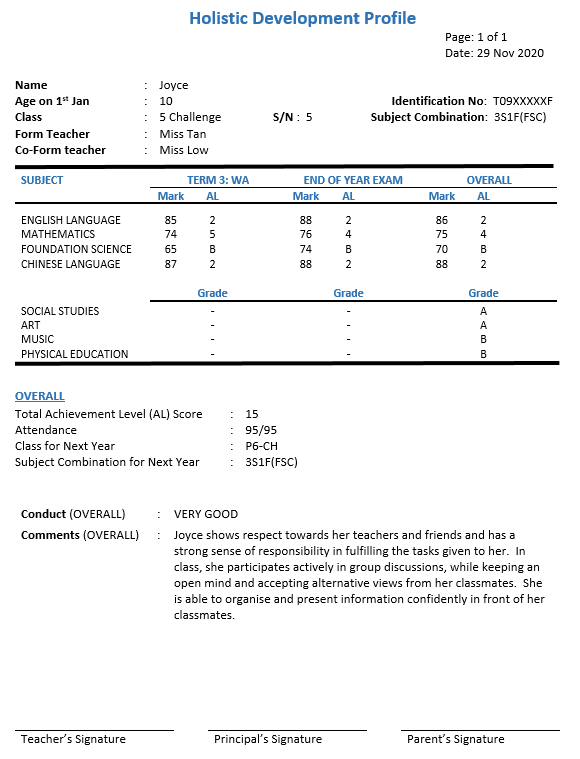Key Features
Students will be scored by Achievement Levels based on their individual performance in the PSLE subject, regardless of how their peers have done. Each Achievement Level will reflect how well students have done relative to learning objectives of the curriculum.
Your child’s PSLE Score will be the sum of the Achievement Levels of their four PSLE subjects (English, Math, Science and Mother Tongue). PSLE Scores can range from 4 to 32, with 4 being the best possible total score.
Example of how a student’s PSLE Score is calculated
| English Language | AL3 |
| Mother Tongue Language | AL2 |
| Mathematics | AL1 |
| Science | AL2 |
| PSLE Score: 8 | |
|---|---|
With 29 possible PSLE Scores, students' examination scores are less finely differentiated, and more students will have the same PSLE Score. Today, more schools with the same cut-off points, and students will have a wider range of schools to choose from depending on their strengths and interests, unique school programmes, and CCAs.
Achievement Levels (ALs) are the scoring bands used for in the PSLE Scoring system.
Each PSLE subject will be scored using 8 ALs. Students who perform similarly will be placed in the same AL for each subject.
| AL | Raw Mark Range |
|---|---|
| 1 | ≥ 90 |
| 2 | 85 - 89 |
| 3 | 80 - 84 |
| 4 | 75 - 79 |
| 5 | 65 - 74 |
| 6 | 45 - 64 |
| 7 | 20 - 44 |
| 8 | < 20 |
To understand the rationale behind the scoring bands distribution, click here.
Under the new AL system, if your child is taking Foundation level subjects, your child will be graded AL A to AL C.
Like ALs for Standard level subject, the ALs for Foundation level subject will reflect a student’s level of achievement, rather than how they have performed relative to their peers.
For the purpose of S1 posting, Foundation level AL A to AL C will be mapped to AL 6 to AL 8 of Standard level subjects respectively, to derive a student’s overall PSLE Score.
| Grades for Foundation | Foundation Raw Mark Range | Equivalent Standard Level AL |
|---|---|---|
| A | 75 - 100 | 6 |
| B | 30 -74 | 7 |
| C | < 30 | 8 |
Under the AL scoring system, students exempted from MTL, due to extenuating circumstances, will be assigned an MTL score so they have a PSLE score comprising four subjects, for the purposes of S1 Posting. Their assigned MTL score will:
- Take reference from peers with similar scores for English, Mathematics, and Science.
- Maintain parity of treatment with students who take Foundation MTL (who will score between AL 6 to 8)
Hence, students will receive an assigned MTL score between AL 6 to 8 in PSLE.
Click here to find out how a student’s MTL score is assigned.
Students who obtained Distinction/Merit/Pass in HCL and a PSLE Score of 14 or better (i.e. PSLE Score ≤ 14) at PSLE will be eligible for posting advantage to SAP schools.
If multiple students with the same PSLE Score apply for places in the same SAP school, those with better HCL grades will be allocated a place ahead of other students. This applies before the tie-breakers for S1 posting.
Secondary school course and subject eligibility
To find out more about the Secondary School experience under Full Subject-Based Banding, click here.
For your child to take HMTL, your child should meet the following criteria:
| Eligibility Criteria for Secondary School HMTL |
|---|
| (i) An overall PSLE Score of 8 or better OR (ii) An overall PSLE Score of 9 to 14 (inclusive); and attain
|
The eligibility criteria is intended to ensure that your child will be able to cope with the higher academic load. It takes reference from the criteria under the T-score system.
Schools also have the flexibility to allow students who do not meet the above criteria to take HMTL, if they are assessed to have exceptional ability in MTL and are able to take HMTL without affecting their performance in other subjects.
For your child to take a third language in secondary school, your child should meet the respective criteria:
| Third Language | Eligibility Criterion |
|---|---|
| Foreign Languages (FL) (French, German, Japanese and Spanish) |
|
| Asian Languages (AsL) (Arabic and Bahasa Indonesia) |
|
| Special Programmes [Malay Special Programme M(SP) and Chinese Special Programme C(SP)] |
|
Read this list of commonly asked questions and answers on the new PSLE scoring system.


